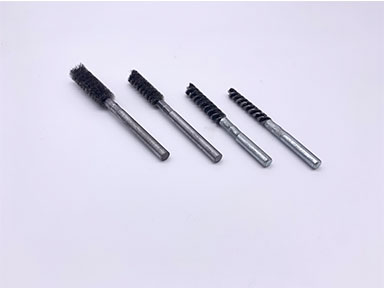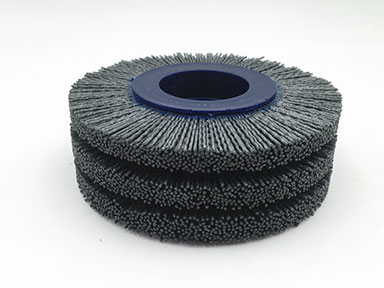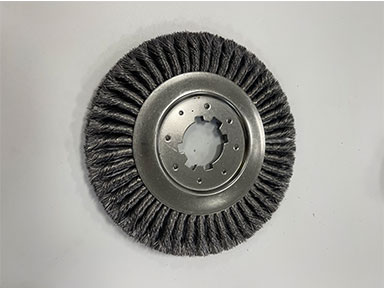Deburring is a problem faced by all metal processing enterprises. The size of the burr directly affects the accuracy, quality, and life of the product. Most of our deburring brushes are designed for the polishing of metal parts. The principle is to use abrasive fiber with strong cutting ability, which can be rotated at high speed to remove burrs and won't damage the workpiece. Our company designs a variety of professional industrial brushware, for different shapes, materials of the parts, welcome customers to come to consult us.
What is a Deburring Brush?
Burrs are everywhere in the metalworking process. No matter how advanced the precision equipment you use, it will be born along with the product. It is mainly a plastic deformation of the material that generates an excess of iron filings at the processing edge of the material being machined, especially for ductile or tough materials, which are particularly prone to burrs.
Brush deburring is the use of special deburring brushes (round deburring brushes, bowl deburring brushes, wide deburring brushes, side grinding deburring brushes, bottom grinding deburring brushes, straight line deburring brushes, bending deburring brushes, flexing grinding hole deburring brushes, etc.) to grind and deburr the workpiece by driving (or manually) the deburring brush rotation, and also to chamfer, micro-finish and polish the workpiece. This deburring method is divided into dry deburring and wet deburring. Deburring brushes can be divided into metal type deburring brushes and non-metal type deburring brushes. The applicable range of various deburring brushes is selected according to the part shape, material, burr area, and size. When deburring, the abrasive brush rotates and makes axial feed, the deburring brush produces grinding on the workpiece and the burr is removed. This method is widely used because of its simple operation, easy movement, and low cost.
Surface grinding and deburring brush
Particularly suitable for automation on production lines, deburring brushes can be directly installed on CNC machining centers, lathes, robots, special machines, etc. Such as deburring brushes for CNC machines. At the same time for burr removal and processing surface polishing, remove the knife cutting knife marks, improve the quality of the processed parts consistent, save man-hours and labor costs. Deburring brushes are especially suitable for processing parts with high surface treatment requirements, such as deburring brushes for aluminum, cell phones, laptop cases, 3C products, magnesium alloy, stainless steel materials.
Polishing and deburring brushes are used to deburr and polish the appearance of the throw surface. It is necessary to determine the type and characteristics of the brush wire according to the requirements of the difference and the appearance of the polishing brushes if the steel plate is strong. For plating and polishing, the ideal deburring wire brush should be bronze wire, and the hardness of the accepted wire can be better if it is rust-proofed and deburred for appearance, as is usually the case with metallic materials.
Deburring brushes for CNC machines
Deburring brushes are indispensable tools used in CNC (Computer Numerical Control) machines to eliminate burrs and sharp edges from machined parts. These deburring brushes play a crucial role in ensuring the high quality and smooth finish of the final product. Here are the key applications and benefits of deburring brushes for CNC machines:
Burr Removal: Deburring brushes for CNC machines effectively eliminate unwanted burrs, sharp edges, or thin metal protrusions that can occur during CNC machining. This is essential for achieving a smooth surface finish and ensuring parts can be handled safely without the risk of cuts or abrasions.
Surface Finishing: These deburring brushes for CNC machines improve the overall surface finish of machined parts by smoothing out minor irregularities or imperfections. This enhances the aesthetic appeal of the final product and prepares the surface for subsequent processes like painting, plating, or assembly.
Edge Rounding: Deburring brushes for CNC machines can gently round the edges of machined parts, reducing the risk of injury and improving the product's appearance and feel. This is particularly important for parts that require frequent handling or must meet specific safety standards.
Automated Deburring: Integrating deburring brushes for CNC machines into CNC machining automates the deburring and finishing tasks, enhancing efficiency and reducing manual labor. This leads to quicker turnaround times, increased production capacity, and consistent quality control.
Versatility: Available in various sizes, shapes, and bristle materials (such as stainless steel, nylon, or abrasives), deburring brushes for CNC machines accommodate different part geometries and material types. This versatility allows CNC operators to choose the most suitable brush for each application, ensuring optimal results.
By integrating deburring brushes for CNC machines into the CNC machining workflow, manufacturers can significantly enhance the quality, safety, and appearance of their parts. This integration also improves operational efficiency, reduces manual deburring efforts, and boosts overall production capabilities.
Shanghai Longguang Industrial Brushware Ltd Looking forward to providing you with quality industrial brushware services and establishing long-term cooperative relations.
Explore More Popular Longguang Products:
 en
en 



